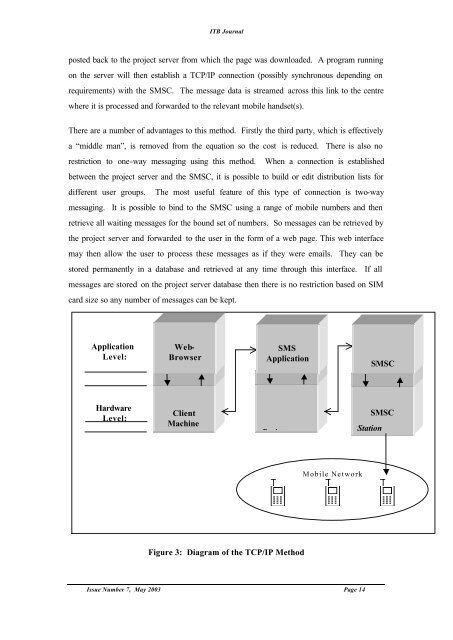ITB Journal-May-2003 - Institute of Technology Blanchardstown
ITB Journal-May-2003 - Institute of Technology Blanchardstown
ITB Journal-May-2003 - Institute of Technology Blanchardstown
You also want an ePaper? Increase the reach of your titles
YUMPU automatically turns print PDFs into web optimized ePapers that Google loves.
<strong>ITB</strong> <strong>Journal</strong><br />
posted back to the project server from which the page was downloaded. A program running<br />
on the server will then establish a TCP/IP connection (possibly synchronous depending on<br />
requirements) with the SMSC. The message data is streamed across this link to the centre<br />
where it is processed and forwarded to the relevant mobile handset(s).<br />
There are a number <strong>of</strong> advantages to this method. Firstly the third party, which is effectively<br />
a “middle man”, is removed from the equation so the cost is reduced. There is also no<br />
restriction to one-way messaging using this method. When a connection is established<br />
between the project server and the SMSC, it is possible to build or edit distribution lists for<br />
different user groups. The most useful feature <strong>of</strong> this type <strong>of</strong> connection is two-way<br />
messaging. It is possible to bind to the SMSC using a range <strong>of</strong> mobile numbers and then<br />
retrieve all waiting messages for the bound set <strong>of</strong> numbers. So messages can be retrieved by<br />
the project server and forwarded to the user in the form <strong>of</strong> a web page. This web interface<br />
may then allow the user to process these messages as if they were emails. They can be<br />
stored permanently in a database and retrieved at any time through this interface. If all<br />
messages are stored on the project server database then there is no restriction based on SIM<br />
card size so any number <strong>of</strong> messages can be kept.<br />
Application<br />
Level:<br />
Web-<br />
Browser<br />
SMS<br />
Application<br />
SMSC<br />
Hardware<br />
Level:<br />
Client<br />
Machine<br />
Project<br />
Station<br />
SMSC<br />
Mobile Network<br />
Figure 3: Diagram <strong>of</strong> the TCP/IP Method<br />
Issue Number 7, <strong>May</strong> <strong>2003</strong> Page 14
















